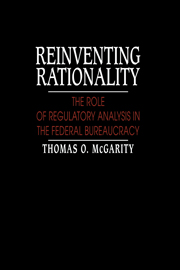Book contents
- Frontmatter
- Contents
- Acknowledgments
- Abbreviations
- Introduction
- Part I The clash of regulatory cultures
- Part II Regulatory analysis in theory and practice
- Part III Structuring regulatory analysis into the decisionmaking process
- 11 Roles for the regulatory analyst
- 12 The hierarchical model
- 13 The outside advisor model
- 14 The team model
- 15 The adversarial model
- 16 A hybrid model
- 17 Selecting the right model
- Part IV Review of regulatory analysis
- Part V Conclusions
- Notes
- Bibliography
- Index
17 - Selecting the right model
Published online by Cambridge University Press: 16 October 2009
- Frontmatter
- Contents
- Acknowledgments
- Abbreviations
- Introduction
- Part I The clash of regulatory cultures
- Part II Regulatory analysis in theory and practice
- Part III Structuring regulatory analysis into the decisionmaking process
- 11 Roles for the regulatory analyst
- 12 The hierarchical model
- 13 The outside advisor model
- 14 The team model
- 15 The adversarial model
- 16 A hybrid model
- 17 Selecting the right model
- Part IV Review of regulatory analysis
- Part V Conclusions
- Notes
- Bibliography
- Index
Summary
The foregoing analysis of the five most prominent models for structuring regulatory analysis into the decisionmaking process suggests that no single model is best for all regulatory programs. Different agencies have different degrees of discretion; different programs have different levels of complexity; different agency heads have different management styles; and the likelihood of attracting highquality technical and analytical personnel varies from agency to agency. Hence, rather than attempting to prescribe a single “best” approach to incorporating regulatory analysis, this chapter will focus upon the considerations that might guide a particular agency toward one or another of the available models.
The hierarchical model is well suited for agencies that regulate according to statutes that articulate clear policy goals and provide very little agency discretion. It is probably best adapted to agencies engaged primarily in “economic” regulation where costs and benefits analyses demand the same kind of expertise and can easily be reduced to the same units. The hierarchical model will not be as useful for agencies engaged primarily in social regulation, where gathering information on costs and benefits might require an entirely different mix of training and skills. This may explain why the Food Safety and Inspection Service in USDA, which is one of the few agencies in that department with large consumer protection responsibilities, appears to be evolving away from the hierarchical model that characterizes most of the other agencies in the department.
Because the hierarchical model lacks a designated institutional skeptic, it will function best in a standardized regulatory context in which there are few realistic options and there can be little dispute over the validity of the available information.
- Type
- Chapter
- Information
- Reinventing RationalityThe Role of Regulatory Analysis in the Federal Bureaucracy, pp. 263 - 268Publisher: Cambridge University PressPrint publication year: 1991



